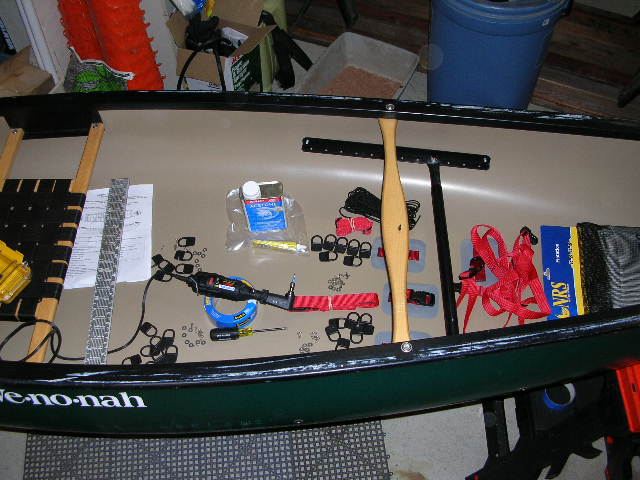...more recent posts
Canoe Guy @ Albion
D and I camped near Mendocino with her kayak club and did a little paddling. There were all kinds of craft -- a couple surf kayaks, some plastic touring kayaks, some long, sleek fiberglass kayaks, at least one greenland style kayak, a few chunky recreational kayaks, and a one green royalex canoe. So I was dubbed Canoe Guy.
Most of the group went to the Big River, right at the town. A few of us ventured to the Albion River, a few miles south of town. The Albion is an estuary this time of year. I imagine it must have some significant flow in the winter, because it had a deep central channel. Unlike Elkhorn Slough, the Albion is navigable by small craft -- providing you avoid the logs.
The channel is marked by large pylons, probably the remains of a logging operation. I used those channel markers to practice a turning technique called edging. To turn left, the canoe is leaned over onto its right side. The corner where the side of the canoe and the bottom of the canoe meet is called a chine. The right chine is curved in a manner that, when leaned into the water, causes the canoe to turn left. The effect is stronger the faster the canoe is moving, as the chine is better able to carve the water.
By the end of the trip, I was able to do a fairly sharp turn in the canoe with no turning strokes. Just a forward stroke to move and a lean to turn.
The round trip was about 5 hours including a lunch and a swim. Not all of us swam, just the two participants who dumped their boats. Mine was due to excessive edging in a shallow canal clogged with submerged branches. When you hit something while the gunnel is two inches from the river, bad things happen.
The other paddler was attacked by branches from above. We had pressed through into a very tiny channel despite the fact that the river was overgrown with brush. While I was still climing back in, she was just going in for a swim after being whacked by a branch. D went over to help. This being D's first club paddle as an official trip leader (of the Albion contingent), she wanted to get her friend back in quickly and safely. Wouldn't do to have casualties on your first go.
Kayakers have all these complicated rescue techniques based on being safe in cold ocean water. Flat water canoers have rescue techniques based on being in shallow water, getting wet, and getting your feet muddy. So I climbed back out of my boat, waded over, and did a kayak rescue canoe style.
Between the wind, the distance, the swimming, we had a pretty good workout. The canoeist of the group, in particular, got a workout paddling into headwinds and quartering winds. By comparision, the Big River contingent had a two hour, slow paddle.
The Albion is a quiet, lazy backwater. There were some noises in the distance, probably a lumber operation. But other than that, one felt miles away from other people. Looking at the map, I was surprised how close the roads were. Without converting it to park land, I can't imagine it looking the same in twenty years.
Canoe Bashing
The abuse I take ...
Mark,
Confusion about watercraft is fairly common and especially severe when one paddles perched high above the water surface. It is a well known fact that sitting on or near the floor of the boat promotes a balanced joining of the paddler with boat. In this balanced position the energy flow from the water to the paddler is strong and uninterrupted. This enhanced energy state allows the kayak paddler to experience an almost perfect or nirvana-like state of mind. Confusion over why one would paddle perched on a lawn chair in kayak-shaped deck-less boat dissolves.........
I hope that helps your canoe confusion...
Love, D
Re-Entry
I went to the pool with D and C and at least 10 other kayakers. Mostly sea kayaks, three whitewater play/rodeo boats, and one float-bagged Wenonah.
There was a bit of chatter about the undecked craft. "What's the deal with canoes?" "They're great boats ... for a lady." "That sure is a lumpy canoe." "Are you gonna roll it?" Ha. Ha.
I focused on capsizing, righting the canoe, and getting back in. I had the most success with capsizing. I nailed that one. With float bags, righting the canoe with minimal water in the bilge is amazingly easy. Climbing back in was a bit more difficult.
In shallow water I can do a solo re-entry, but need to work on my balance once I'm back in the boat. It's pretty easy to roll right back into the drink. Staying low to the gunnel seems to be the thing. And making smooth motions.
In deeper water I can't boost myself high enough on the gunnel to do a solo re-entry. Many years ago, I could do this. But that was then. I think I could do it with some swim fins, becaue I just need a few more inches of height. A paddle float lashed to a thwart across the top of the gunnel is another idea I'd like to play with for solo re-entry.
With someone steadying the canoe at the opposite gunnel, from the water or from a kayak, I had enough stability to wriggle up across the gunnels and get back into position.
Fun was had by all. It was about a three Advil evening.
Flotation
Installation of North Water Rescue flotation lashing kit and NRS float bags in a 2004 Wenonah Vagabond constructed of Royalex.

The installation is documented in about 20 photos. Follow the "read the rest" link for the full montage. Wet photos coming soon.
